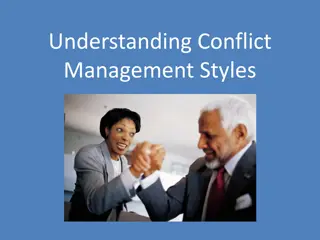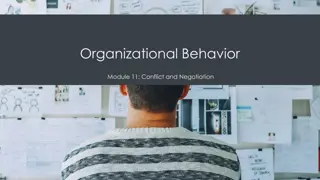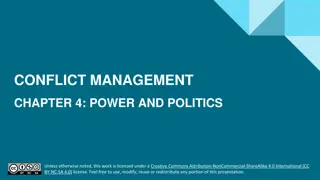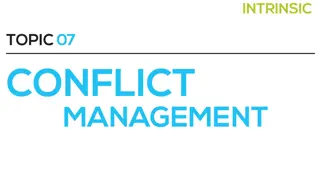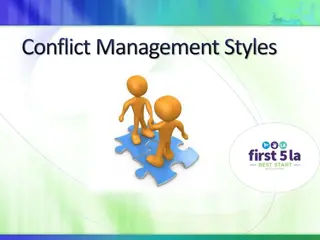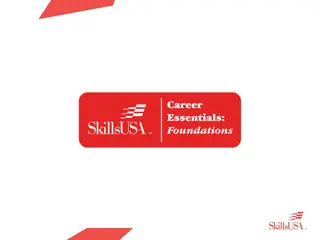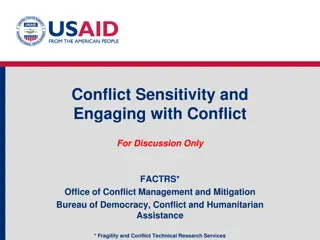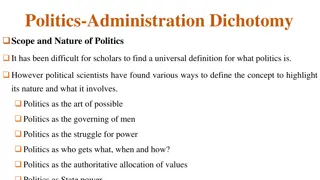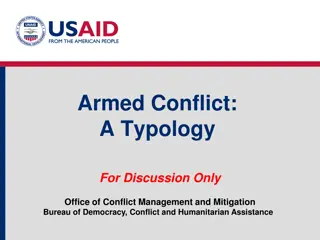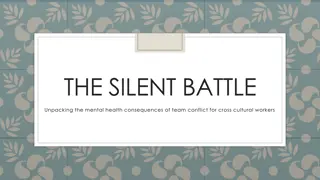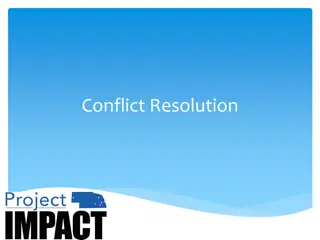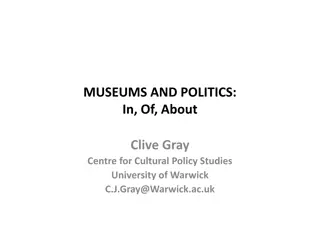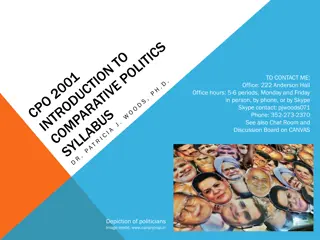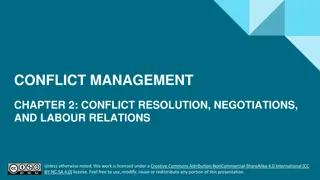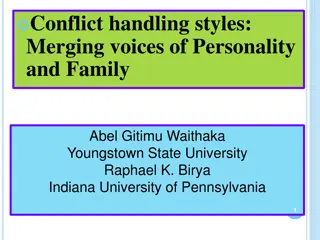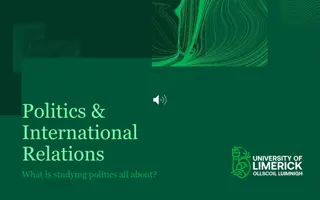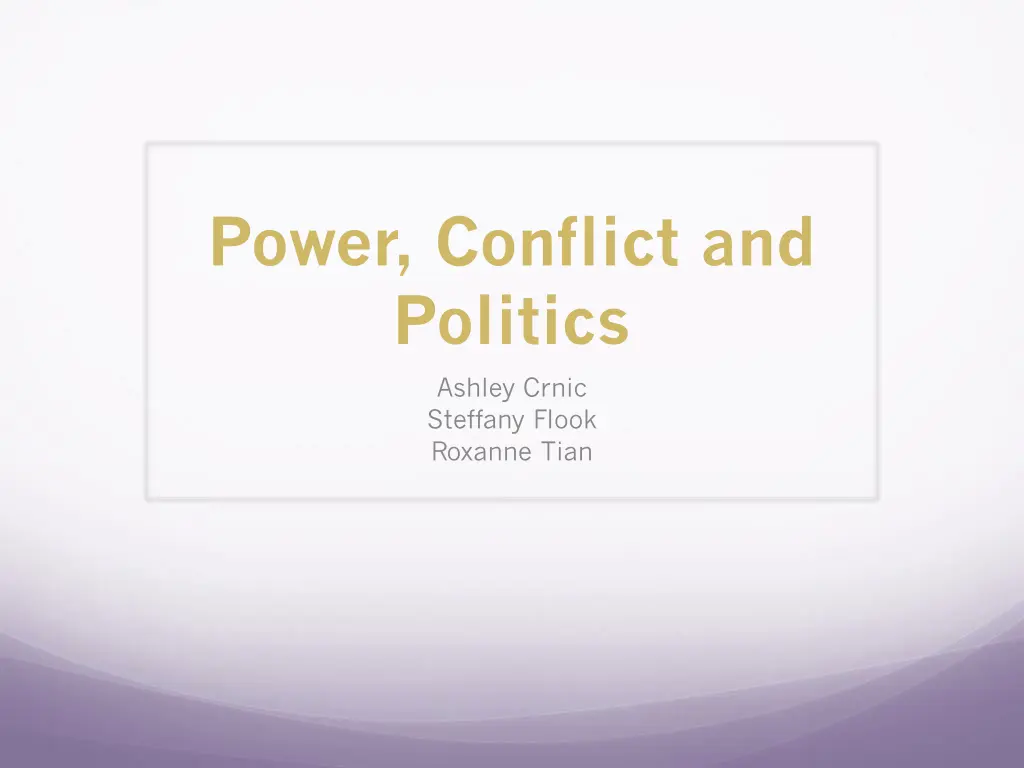
Understanding Workplace Conflicts: Types and Resolutions
Explore the types of conflicts witnessed in workplaces, their underlying reasons, intergroup conflict dynamics, sources of conflict, and the rational vs. political models of behavior. Gain insights into internal and external influences shaping conflict management strategies within organizations.
Download Presentation

Please find below an Image/Link to download the presentation.
The content on the website is provided AS IS for your information and personal use only. It may not be sold, licensed, or shared on other websites without obtaining consent from the author. If you encounter any issues during the download, it is possible that the publisher has removed the file from their server.
You are allowed to download the files provided on this website for personal or commercial use, subject to the condition that they are used lawfully. All files are the property of their respective owners.
The content on the website is provided AS IS for your information and personal use only. It may not be sold, licensed, or shared on other websites without obtaining consent from the author.
E N D
Presentation Transcript
Power, Conflict and Politics Ashley Crnic Steffany Flook Roxanne Tian
Discussion What types of conflicts have you witnessed in the workplace? Why do you think they occurred?
Intergroup Conflict in Organizations Three ingredients: 1) Group Identification 2) Observable Group Differences 3) Frustration
Sources of Conflict 1) Goal Incompatibility 2) Differentiation 3) Task Interdependence 4) Limited Resources The sources of conflict are related to EGSS. How?
Rational vs. Political Model of Behaviour Rational Decisions made in a logical way Used when goals are in alignment, pooled interdependence and abundant resources Like rational decision making, the choice with the highest probability of success is selected Little to no conflict involved
Rational vs. Political Model of Behaviour Political Used when differences are great, groups have different interests, goals and values Disagreement and conflict are high Used commonly in learning environments where employee participation is encouraged
Internal Influences When When Conflict Is Low Rational Model describes the organization Conflict Is High Political Model describes the organization Organization Variables Sources of Potential Inter-group Conflict Consistent across participants Inconsistent & numerous within the organization Goals Goal Centralized Decentralized, shifting coalitions and interest groups Power and Control Incompatibility Differentiation Orderly, logical, rational Disorderly, result of bargaining and interplay among interests Decision Process Task Interdependence Conflict is legitimate and expected. Rules and Norms Norm of efficiency Limited Resources Extensive, systematic, accurate Ambiguous, information used and withheld strategically Information
External Influences Simple Environment Stable Environment RATIONAL (Management Science) Reliable Information Routine Technology Complex Environment Unstable Environment POLITICAL (Carnegie Model) Non-routine Technology Disagreement
Power and Organizations Structure 1) Framework 2) Interactions
What is Power? Intangible force Felt internally Power can result from structural characteristics Structural characteristics= influences strategy and goals Horizontal structures or vertical structures
Power and EGSS Definition Ability to achieve goals or outcomes that power holders desire Influence other people to bring about desired outcomes Is power in the hands of the director or the directee?
Power derives from An exchange relationship in which one position or department provides scarce or valued resources to other departments Dependency= power relationship How does power affect organic and mechanistic structures? Is power more dominant in vertical or horizontal structures?
Individual vs. Organizational Power 5 sources of personal power 1) Legitimate Power (granted) 2) Expert Power (greater skill/ knowledge) 3) Referent Power (personal characteristics) 4) Reward Power (bestow rewards) 5) Coercive Power (punishment)
Question Which comes first power or structure?
Authority force prescribed by formal hierarchy 3 properties: 1.Authority vested in organizational position 2.Authority accepted by subordinates 3.Authority flows down from vertical structure What is the difference between power and authority regarding EGSS? Can you have authority but not power?
Vertical Sources of Power Access to power in a functional structure & allocation 1.Formal Position (Accrued) 2. Resources (Downward) Building are constructed, salaries are paid, and equipment & supplies are purchased 3. Control of Decision Premises and Information (primary business source) 4. Network Centrality (Access) 5. People (Coalitions)
Horizontal Sources of Power Level of power defined by role of department when corporation dealing with key resources issue Deals with the relationships across departments Those departments (or individuals) able to successfully deal with activities essential to the organization will be the most powerful Strategic Contingencies
Strategic Contingencies Approach Events and activities that are essential for attaining organizational goals Influence horizontal sources of power among departments Departmental activities are important when they provide strategic value by holding important information, resources or ability to solve a problem
Power Sources Dependency on the department by others for information, resources and/or assistance Proximity to the organization s critical activity (Centrality) Ability to bring in money (Financial resources) Ability to reduce, prevent or absorb uncertainty for others (Includes forecasting events and trends) Degree to which a department or person is irreplaceable (Nonsubstitutability)
Politics A way of using power to achieve ones goals Appropriate use of politics can achieve organizations goals (negative and positive) Politics help reach agreements when decisions are unprogrammed and uncertainty is high (Carnegie model)
Domains of Political Activity Areas in which politics play a role : Structural reorganization Resource allocation
Collaboration Create integration devices (teams, task forces, integrators, labour- management teams) Rotation of workers (promote compatible subcultures) Create shared mission and superordinate goals How do these relate to EGSS?


